 The Master and Student faced off from across the icy field. The student lunged first and his katana devastatingly slashed some bamboo that was nearby. Meanwhile, the Master side-stepped and blocked an attack that wasn’t coming, unless that rock decided now was it’s time to strike.
The Master and Student faced off from across the icy field. The student lunged first and his katana devastatingly slashed some bamboo that was nearby. Meanwhile, the Master side-stepped and blocked an attack that wasn’t coming, unless that rock decided now was it’s time to strike.
But it wasn’t time, so it stayed inanimate as rocks typically do.
Their eyes narrowed at each other as the wind blew some blossoms off the cherry tree. Who would make the next move?
Senjutsu: Battle for Japan is a 1-4 player game where players battle as various samurai against each other or as a solo player campaign.
Gameplay Overview:
This will just be a brief explanation of the major rules since there are a lot of exceptions that come up throughout play. Before beginning players can either customize their deck of cards or use pre-generated decks. Players will set their tokens on the advantage track and set the kame tracker on the neutral space. Players start with a hand of cards that includes a character-specific core and weapon card.

At the start of a turn, each player draws a card to their hand and then selects a card they want to play and places it face down. Once all the players have selected a card, each player pays their card’s required costs starting with mandatory costs and then any optional costs. Then, starting with the bottom of the advantage tracker, players can opt to use an instant replacement card (also paying any mandatory costs, if any).
Players with variable initiative cards can pick the speed they want it to activate at (these cards are usually defensive cards). Cards are then activated from highest to lowest initiative values with ties being broken by the type of card played (Defense, Attack, Meditation, and Core). If still tied, the player with the higher advantage chooses the order.
Effects of cards are often movement, inflicting damage, drawing cards, adding statuses like hobble or stun, or blocking attacks. Some actions are required while others are optional or are only available depending on where you are on your Kame tree.
Move all played cards to the discard pile, except for core and weapon cards which return to your hand. Then trigger any end of turn effects and discard down to your hand size.
The game continues until only one character or team are still standing, usually accomplished by dealing five damage to each character (this value changes in solo mode based on the number of enemies you’re battling).
The solo mode is played against AI decks and is a campaign that also doubles as a graphic novel/comic. Each scenario has you build specific decks for the enemies giving each enemy a slightly different feel.
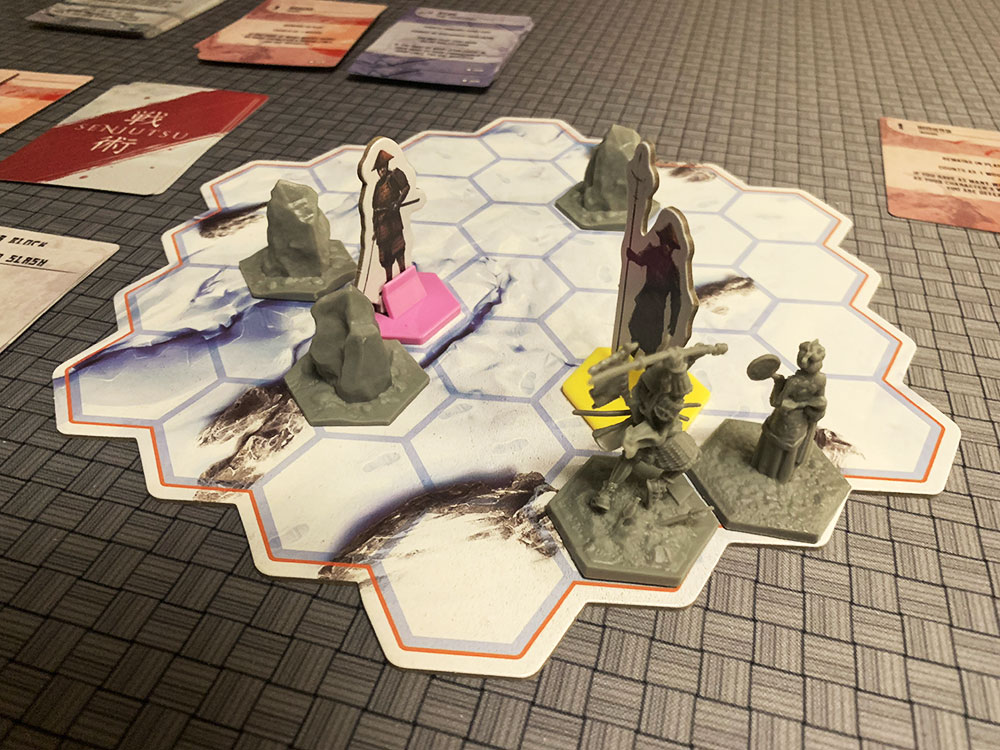
Game Experience:
At its core, Senjutsu is a simple game—everyone draws a card and then they activate them in initiative order. Then this simple core is wrapped up in minutia that adds depth but doesn’t make it more satisfying for me. The reason why was too often, I felt like my success or failure was a matter of luck more than of skill or being clever. The simultaneous card draws leads to some neat moments as you defensively jump away before your opponent’s lunging strike or you time your block perfectly. But for each of those, I felt like I was attacking the air and blocking in the wrong direction. There is an aspect of you’re playing the person across from you and being able to read your opponent is as important as the battle on the board.
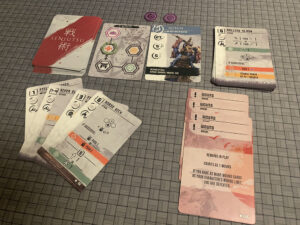
Sometimes you’re just trying to get close enough to hope you draw a useful card. And I found that I generally preferred trying to hit opponents more than defend to try and win that race to deal five damage first. Getting stun cards in your deck can start a bit of a death spiral as they clog your deck unless you play one to lose that turn. A saving grace of this runaway leader problem is the games are relatively short but I don’t know if I would ever want to play this at three or four players due to player elimination and what I’d assume is a longer overall game length.
Adding to the decisions you get to make each turn is the focus resource to gain and spend as well as Kame stances. The stances are triggered by cards and some cards require specific stances to be used. So if you have a really cool attack card but no cards that allow you to move into that stance or any focus to use, you’re stuck or using your core cards, which tend to be slow. Disney’s Sorcerer’s Arena allowed cards to be used for a nominal move/attack or their card specific action making them far more flexible and that being missing from here is a negative.
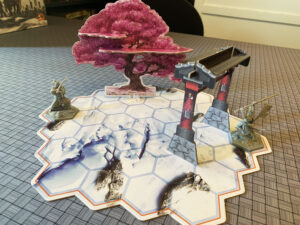
The production of the game is good and the miniatures and terrain look great. The cherry tree and Torii gate standees really gave the board a nice wow factor. I also really appreciated the miniatures having arrows that tell you front to make actions clear (the standees stands didn’t have arrows but the art is clearly two sided making it pretty easy to figure out).
Something that may appeal to some players is the deck building portion of the game. That’s not something I dove into but it’s there and I could see that as an interesting piece if deck construction games are your jam. I really dislike dumping on a game but I found it frustrating that I had to build decks for regular play and then take cards from those to build a deck for solo play, making this annoying and time consuming to go back and forth between. It’s possible that was a result of the specific characters I was using but it was worth noting for people that plan to hop back and forth between solo and multi-player play.
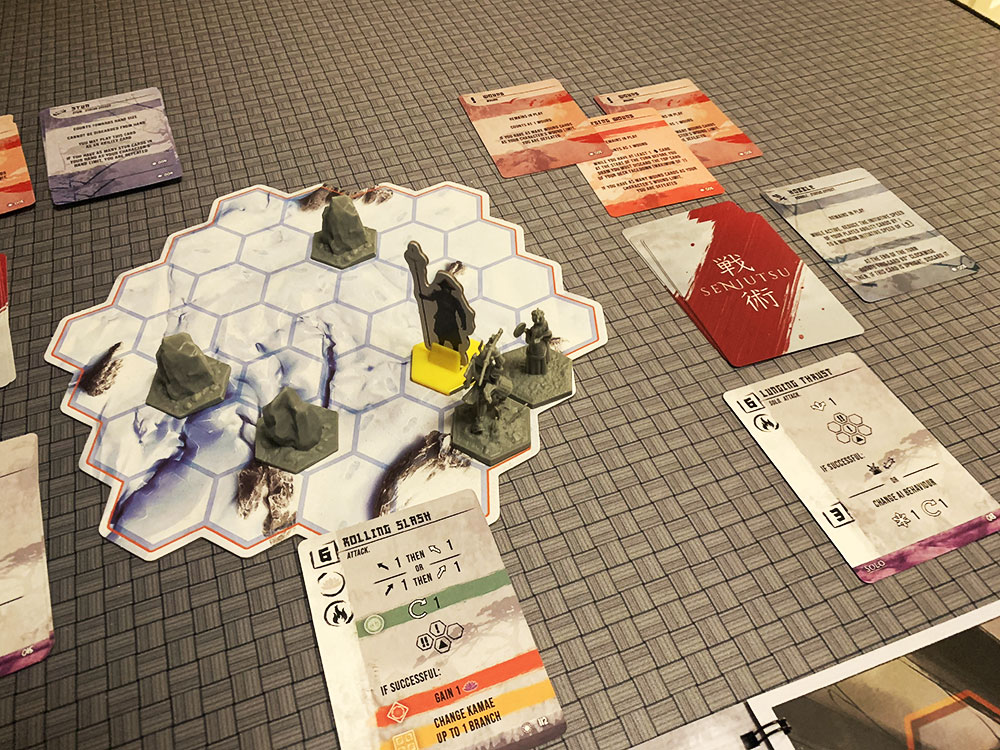
Final Thoughts:
I wanted to like Senjutsu: Battle for Japan and it seemed like it was up my alley. It looks great, has a neat theme, and there are some cool concepts in here. It was okay but I have a hard time recommending it over Unmatched or Disney Sorcerer’s Arena in terms of overall experience. Ultimately, I felt like I was playing roshambo with a lot of unnecessary mental overhead.
Final Score: 2 Stars – Senjutsu has some cool ideas but the randomness makes it feel unsatisfying.
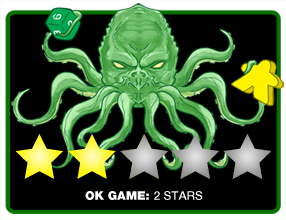 Hits:
Hits:
• Looks nice and has cool 3D terrain
• Deck construction for customized character decks
• Solo campaign
Misses:
• Card play feels random
• Simultaneously too simple and too complicated
• Have to rebuild decks between solo and competitive play
Source: Board Game Quest





